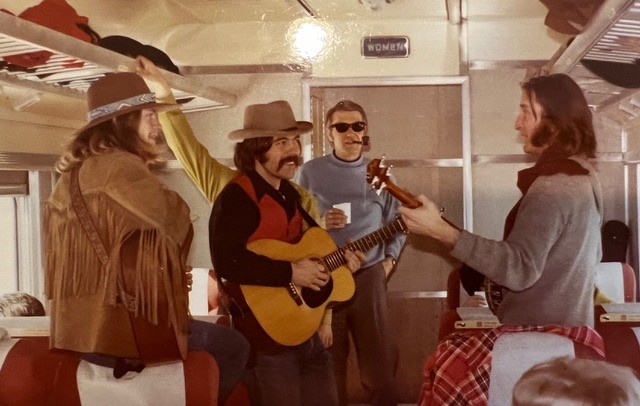Saturday February 27, 1971 provided a rare opportunity to experience a historic event: riding the final passenger train to Park City. The occasion received extensive media coverage. Trains began serving Park City in 1880. Regularly scheduled passenger service ended in the early 1950s. Freight service continued until 1988.
Special winter excursions had commenced in 1936. These trains, always popular, coincided with Park City’s annual Winter Carnival. Such events, promoted by Salt Lake City, Ogden, and Park City, showcased the town’s winter recreation possibilities. Skiing, sledding, sleigh rides, kite flying, and ice sculpting represented some of the more popular activities.
After an extended hiatus, these winter extravaganzas and the trains to transport the revelers were resurrected on December 4, 1965. In addition to the SLC, Ogden and PC Chambers of Commerce, a new sponsor emerged: the Utah Olympic Organizing Committee, as the state had submitted a bid to host the 1972 Winter Olympics. The proposal highlighted Park City and its unique ability to accommodate the Olympics.
The ski train, named the Hootspa Special, departed the Union Pacific’s (UP) majestic SLC Depot that December day at twelve noon. Enroute the train stopped at Ogden Station to pick up additional patrons. It arrived in Park City at 4:30 p.m., thirty minutes past due. The sold-out train (350 passengers) featured local dignitaries, Hollywood stars, famous athletes, and representatives from forty different travel agencies. It would return to SLC that evening departing Park City at 8 p.m. The following year the excursion was renamed the Snowball Express.
The 1960s and early 1970s were a tumultuous period for the nation’s railroads. Excessive taxation, antiquated work rules, burdensome regulations. and a free fall in passenger revenue ruined the balance sheets of all rail operators, including the mighty Union Pacific. Responding to the crisis, in 1970 the Nixon Administration garnered bipartisan support to essentially nationalize intercity passenger service. Effective May 1, 1971 a new Federal entity, Amtrak, would operate long distance passenger trains. The opportunity to rid itself of money losing passenger operations was compelling – UP announced that they would join Amtrak. One of the many stipulations associated with joining Amtrak required the participating railroads to abandon passenger service. Special excursions, such as the Snowball Express, were not exempt. Thus, the curtain would fall on February 27, 1971.
Considering the nostalgic opportunity to ride the final passenger train to Park City, that last Snowball Express sold out. The train would follow the same route as its predecessors. Departure time was set for 9 a.m.

Credit: Courtesy of Leland Flinders
The Snowball Express enjoyed a well-deserved reputation as a party train. Not subject to local liquor laws, the train’s bar cars poured boozy refreshments. Additionally, two of the ten cars were retrofitted to accommodate live music and dancing. The bands Slocum and Slum Gullions would provide entertainment. When not performing, the band personnel mingled with the passengers.
For this historic occasion, Park City planned a reception for the ages. Mayor Sullivan, local dignitaries, and the renowned Park City High School Band would greet the train. Lewis Brothers Stage Lines provided free transportation to Main Street, C’est Bon, Park City Mountain Resort and Park West. Considering that the previous five excursions had been at least thirty minutes late, schedules were set accordingly. Uncharacteristically, the train arrived on time (1p.m.). A mad scramble ensued as the welcoming committee hastily assembled. No problem. For those disembarking the train, they were clueless as to the pandemonium that ensued immediately prior to their arrival.
At 4:45pm the engines sounded their horns, signaling it was time to reboard the train for its 5 p.m. departure – and a place in history.
The Park City Museum will host a train themed lecture called “Snowbound” given by David Nicholas and Stuart Stanek on Wednesday February 28 from 5-6 p.m. at the Park City Museum’s Education and Collections Center located at 2079 Sidewinder Drive.
Acknowledgements: The author expresses his appreciation to Alan Dearden, Leland Flinders, Steve Leatham, and Scott Smith for contributions to this article.